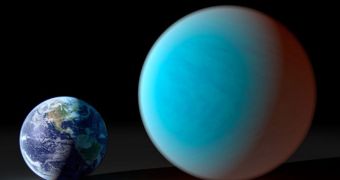During a recent study it conducted on the extrasolar super-Earth-class planet 55 Cancri e, the NASA Spitzer Space Telescope was able to produce a detailed view of the object that revealed several new details astronomers did not know before.
This particular exoplanet is a super-sized and superheated version of our own planet. Super-Earths are a category of cosmic objects that are rocky just as our planet, but are several times more massive.
What Spitzer discovered is that 55 Cancri e is significantly less dense than what astronomers had first calculated. This discovery is very important, since it hints at mistakes made in calculating other traits of the object that depend on density.
What's even more important is that Spitzer data are suggesting the world may be drenched in water vapor and other gases. Given its close proximity to its parent star, the day side of the planet is incredibly hot, most likely featuring a molten surface.
Until now, astronomers believed that 55 Cancri e was a densely-packed world orbiting close to its parent star, 55 Cancri. But the new data indicate that it may in fact be one of the few exoplanets known today that may have some form of water on its surface.
The infrared NASA telescope was able to conduct its studies during transits the super-Earth made between its delicate IR sensors and its parent star. These mini-eclipses of sort can reveal a lot about exoplanets in general, provided that sufficiently-sensitive instruments are used.
“This work demonstrates that 'warm' Spitzer can measure an extremely faint eclipse caused by exoplanets' transits with very high precision,” Brice-Olivier Demory explains. He is a postdoctoral associate in the Massachusetts Institute of Technology (MIT) Earth, Atmospheric and Planetary Sciences Department.
The research “emphasizes the important role Spitzer still has to play for the detection and characterization of transiting planets,” adds the expert, who is based in professor Sara Seager's group.
Details of the new study, on which Demory was a lead author, have already been accepted for publication in an upcoming issue of the respected scientific journal Astronomy&Astrophysics.
“55 Cancri e orbits a very bright star thus enabling the possibility of obtaining a wealth of observations with space-based facilities at various wavelengths,” University of Liege principal investigator and study coauthor Michael Gillon adds.
“This fact will make 55 Cancri e a landmark for our understanding of the planetary interior and atmospheric composition of super-Earths,” he concludes.

 14 DAY TRIAL //
14 DAY TRIAL //